Geneva Motor Show 2010
Geneva 2010 marked a return to simple lines, elegant forms and fresh optimism. There appeared to be an almost unified attempt to address and shape emerging new themes in the motor industry, as companies stepped up with myriad solutions for a design language that engaged with sustainable mobility.
Mike Robinson, Design Director of Stile Bertone told us: 'We have come to the end of an era and need a new language. We must take advantage of the changing times and not cry about it,' he said admitting: 'It is a fantastic moment for car designers.'
The auto world has taken its time to truly embrace green design. Until the Frankfurt show last September, it almost felt as if some were going through the motions, rather than approaching ecological design with the pulse of excitement necessary to create interesting products.
There have been, off course, exceptions - Audi's e-tron, BMW's Vision Efficient Dynamic, and Renault and Nissan's family of adventurous electric cars, for example. At Geneva, however, almost all marques, including performance-focused Porsche and Ferrari, demonstrated a thoroughly thoughtful approach to housing the modern powertrain. It was, for example, Ferrari's first stab at electrification (however mild). Porsche's designers, on the other hand, formulated a green design language with a high degree of intelligent restraint.
The beautifully sculpted 918 Spyder is a part electric-hybrid supercar. Although still at the conceptual stage, Porsche rarely invests in show cars that do not morph into reality, meaning that the 918 is likely to become the street car sibling of the Le Mans series RS Spyder race car. 'We wanted to show that there is a future with sports cars,' said the company's Design Director Michael Mauer. 'That if you do it in an intelligent way, you can keep the emotional part and still be eco friendly.'
Mercedes-Benz unveiled the F800, built to house either the latest hydrogen fuel tech cell or a plug-in hybrid system. 'It has been developed to be a car for the modern powertrain, and the design should reflect this,' agreed Steffen Köhl, Head of Advanced Design. The F800 is also a teaser for the marque's upcoming design language. With its simple yet precise lines, sophisticated surfacing and light interior inspired by Art Deco, the F800 pays discreet homage to the classic Mercedes of the 1930s without resorting to all-out retro design.
SEAT showcased its IBE concept car, an electric city run around for those on a more modest budget. Its author Luc Donckerwolke set out to expresses the car's modern powertrain. 'We are saying you can have fun driving, be responsible and not feel guilty,' he said.
Wallpaper* Newsletter
Receive our daily digest of inspiration, escapism and design stories from around the world direct to your inbox.
Not all companies, however, focused on an eco-friendly message. Arguably one of the most elegant cars of the show sat on Italian design house Pininfarina's stand. The Alfa Romeo 2uettottanta concept is a vision for a future open top Spider that also celebrates the firm's 80th anniversary and Alfa's centenary.
Design Director Lowie Vermeersch explained: 'The Alfa Spider was one of the cars that started the story of Pininfarina and so we thought the best way to celebrate this was to show a future vision for this car.' His main goal was to work with sleek and classic proportions to give the car what he referred to as 'a touch of class'.
In complete contrast, competing Italian consultancy Bertone unveiled the Pandion, its future vision for the Alfa Spider. This loud and futuristic concept car features vast scissor doors that run the length of the car and stand over 3.6m high when open.
French firms Peugeot and Citroën made a timely return to the design scene with the elegant SR1, which previews Peugeot's upcoming design language, while Citroen added two newcomers to its high-end DS line – the DS3 High Rider and DS Racing. The former previews the upcoming DS4, a rival to the Nissan Juke and MINI Countryman, also unveiled at Geneva. These cars fall into a new trend in smaller 4x4s that strive to offer some of the comfort of larger sports utility vehicles without entirely alienating the green brigade.
One noteworthy unveil was the pint-sized Nissan Micra. In its fourth generation, the car will be built at the all-new Nissan-Renault factory in Chennai in India and is designed for a world market that includes the all-important emerging markets so crucial to the survival of all car manufacturers. This makes the Micra a truly populist car in every sense, one that has to have extremely broad appeal.
Finally, it was left to Aston Martin to ruffle a few feathers through its partnership with the slightly less glamorous Toyota. The result is the ultimate accessory, a premium commuter car. Design Director Marek Reichman described the Cygnet as being akin to a piece of clothing, something more appropriate to slip on when popping in and out of urban areas.
'As our world changes there is a shift in the consciousness of how we drive and get to places,' he told W*. 'It becomes the intellectual choice to have a sports car for the open road, but then in the city have something more appropriate - something that you can manoeuvre, doesn't cost you the earth and takes up less road space.'

Alfa Romeo Giulietta: The production car replaces the entry-level 147. It was originally named the Milano until production was switched to Turin, upsetting the Milanese in the process.
On sale: Summer 2010
Price: from approx £17,000
www.alfaromeo.com

Alfa Romeo Giulietta

Aston Martin Cygnet: Marek Reichman, Design Director at Aston Martin, describes his new – and controversial – city runabout as 'a piece of clothing'. He explains: 'We talk about street fashion, about wearing a suit and being corporate. But when you go in the city you want to wear something cool that looks right in that environment.'
The Cygnet production car is a three-seater based on the Toyota iQ platform, although in the flesh it hardly resembles its rather less premium brother. The exterior package is simple but distinctive, featuring Aston Martin's trademark aluminium grille.
It is inside the cosy cabin, however, where Reichman and his team have used their creative energy the most, surrounding the driver and passengers in soft quilted leather and metal elements – with no plastics in sight. 'We've treated the touch zones with care,' he stresses. With almost every range of accessory available to support the modern commuter lifestyle, the Cygnet is almost like a luxury handbag that can transport you from A to B.
'If the Rapide is the yacht then this is its tender,' notes the designer. 'It is small, precious and very desirable – which gives it a feel good factor. It is the ultimate accessory.'
On sale: late 2010/early 2011
Price: from £30k
www.astonmartin.com

Aston Martin Cygnet

Audi A1 and A1 e-tron: This is the long-awaited MINI rival and an entry-level car for Audi. It will be launched first as a three-door then a five-door Sportback, with sportier variants available down the line.
On sale: October 2010 for A1 and late 2012 for A1 e-tron
Prices: Circa £13k for A1
www.audi.com

Audi A1 and A1 e-tron

Audi RS5: The new coupe is powered by a V8 FSI petrol engine delivering 450PS, and features a new evolution of the firm's trademark quattro all-wheel-drive.
On sale: Spring 2010
Price: circa £57k
www.audi.com

Audi RS5

Bentley Continental Supersport Convertible: Bentley describes this as the world's fastest four-seat convertible. The Supersports accelerates to 62mph in 3.9 seconds, on to a top speed of 202mph. The car has the same twin-turbocharged 621bhp 12-cylinder engine as the Supersports coupe introduced last year and will run on petrol or bio-ethanol fuel.
On sale: Autumn 2010
Price: Circa £175k
www.bentleymotors.com

Bentley Continental Supersport Convertible

Bertone Alfa Romeo Pandion: The second concept celebrating Alfa's 100th anniversary is a futuristic design featuring scissor doors that run the length of the car and stand over 3.6m high when open.
Mike Robinson, new Design Director, says of his bold concept car: 'I wanted the back end to show visual speed. The rear is like the tail of a comet going so fast that these bits are braking loose.' Inside continues the futuristic look with seats that appear to be floating above the floor. 'The centre console is an alien force trying to come out,' admits the designer adding: 'There is a dynamic mix between skin and frame – skin is the sexy part and the frame holds the technical side. So I have tried to find a way of breaking up the two.'
Robinson and his team have intentionally made no references to past Alfa Spiders. 'The idea is that I wanted to exaggerate – this is about the dream, the fantasy,' he notes.
www.bertone.it

Bertone Alfa Romeo Pandion

Bertone Alfa Romeo Pandion

Carlsson C25: Based on the Mercedes-Benz CL, this car is powered by a 743bhp, bi-turbo 6-litre V12 with 848lb ft of torque. Only 25 will be built.
www.carlsson.de

Carlsson C25

Citroën DS Racing: This is the fastest and most powerful hot hatch to be launched by the French marque to date - the 1.6-litre engine is tuned to produce 200hp. Citroën will limit production to 1,000 units.
On sale: Second half 2010
Price: Circa £22k
www.ds3.citroen.com

Citroën DS Racing

Citroën DS High Rider: The original DS remains one of the most iconic cars ever made. Penned by Italian designer Flaminio Bertoni in 1955, the car took on an almost mythological status with French philosopher Roland Barthes devoting a whole chapter to it in his 1957 book Mythologies. Back then Citroën was a marque known for its idiosyncratic design, a distinction lost thanks to a decade of practical cars and low prices. Finally the firm has acknowledged this design-led heritage; hence the new DS range.
This is the second in the DS line following the DS3 launched earlier this year. The three-door, four-seater High Rider is a teaser for the DS4 due early next year. Citroen designer Mark Lloyd insists that the whole DS range will remain 'anti retro'. For this reason like its younger sibling the DS3, it has been designed much like a gadget, with lots of optional finishes for the roof, door mirrors and wheels. The DS3 offers eight dashboard colours with matching gear knobs, while there are four optional roof colours and roof stickers to further personalise your car.
On sale: DS3
On sale: DS4 2011
Price: Start £11k
www.ds3.citroen.com

Citroën DS High Rider

Ferrari 599 hybrid: Ferrari's first (mild) hybrid is a petrol-electric that is rumoured to go into production in the near future.
www.ferrari.com
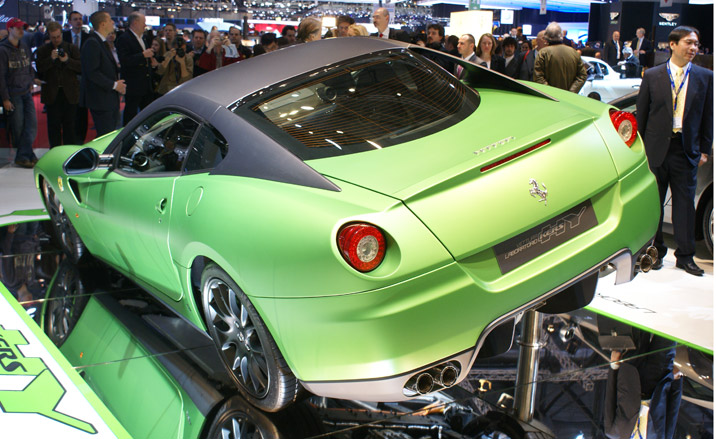
Ferrari 599 hybrid

Hispano-Suiza XIOV: This supercar marks the revival of the famous Hispano-Suiza automotive brand. Based around Audi's R8 V10 with an all-new carbonfibre body, it's suggested that around 25 cars will be built each year, with a convertible to be launched in 2011.
Price: £635k
www.hispano-suiza-sa.com

Hispano-Suiza XIOV

I.D.E.A. Institute's Sofia: Italian design house I.D.E.A. Institute's striking four-seat saloon is designed to use a hybrid powertrain.
www.idea.institute.it

Infiniti M35 hybrid: Infiniti's first hybrid features a system developed by parent company Nissan. The two clutch system installed between 3.5-litre V6 and the electric motor, which allows a relatively high degree of electric intervention, boosting efficiency and lowering CO2 emissions.
On sale: Spring 2011
Price: N/A
www.infiniti.eu

Infiniti M line: This is the first saloon from Nissan's luxury arm Infiniti that has been designed specifically for Europe. With a small portfolio of high performance cars, the company first entered the European market two years ago. The M line now includes a much-needed range of high-performance V6 turbo diesel engines tuned for European driving.
'The London studio is now deep in the Infiniti design process,' admits Vice President of Nissan Design Europe Alfonso Albaisa. Infiniti's subtle take on luxury aims to have Japanese cultural and aesthetic heritage at its core – something that is most evident in the M cars. 'You can see this in the brush works which is like Kabuki makeup,' he says pointing to the 'brow' above the headlights.
On sale: M37 and M30d autumn 2010
Price: Circa £37k
www.infiniti.eu

Lexus Ct200h: The petrol-electric hybrid small car is the production car based on the LF-Ch shown at Frankfurt.
On sale: late 2010
Price: N/A
www.lexus.com

Lexus Ct200h

Lotus Evora 414E Hybrid: This is an engineering demonstrator for Lotus. The hybrid Evora reaches 62mph in less than four seconds thanks to two electric motors generating 408bhp and 590lb-ft of torque at the rear wheels. It uses a lithium-polymer battery to store power and a three-cylinder 1.2-litre petrol engine to recharge the battery. The car can travel 55 km in all-electric mode and about 480 km per fill-up when the onboard engine is employed.
www.grouplotus.com

Lotus Evora 414E Hybrid

Mazda 5: This is the first Mazda production car to feature its Nagare (flow) design theme as seen in recent concept cars.
On sale: Autumn 2010
Price: N/A
www.mazda.com

Mercedes-Benz F800: This is an important car for Mercedes-Benz. On the one hand it shows how the marque intends to package its future cars – it is built to house both a new compact hydrogen fuel cell and the next generation plug-in hybrid - and on the other it is an obvious nod to its future design direction which we will soon see on the entry-level four-door coupé that's due to replace the CLC.
Steffen Köhl, who heads up Mercedes-Benz Advanced Design Studio, explains that this car is the baby brother to the big CLS. He admits that the styling language will filter through to production cars - the front end, specifically, revealing a new brand face. 'Surfaces have become more dramatic and we have a distinctively bolder beltline,' he adds.
The F800 is highly aero efficient thanks to extensive wind tunnel development. This being an essentially a green car, Köhl also set out to express visual lightness. 'You see this on the very natural concave and convex surfaces all over the car. There are fine, natural flowing lines around the car that shape and adapt to one another.'
The cabin, a modern take on Art Deco, will form the base for future production cars. It features light, bendy wood that looks almost untreated to reveal the natural grain. The organically shaped wrap-around dash and floating centre console sit in contrast to the high-tech controls.
www.mercedes-benz.com

Mercedes-Benz F800

MINI Countryman: The Countryman is the fourth model in the MINI range; it is also the first with optional four-wheel drive and four proper passenger seats.
On sale: from September 2010 (UK)
Price: from £16,000
www.mini.com

Nissan Juke: This production car was previewed a year ago at Geneva as the Qazana concept. Designed as a collaborative project between the Nissan studios in Yokohama and London, the road car, built from scratch, maintains much of the bold design of the original show car.
'The motorcycle feel, tilted towards the driver inside is directly from the concept,' says Head of Global Design Shiro Nakamura. 'It is a very functional car but with an unusual look,' he admits. 'We were able to be expressive with the design because it is a small car. If it were even a few centimetres bigger it would seem aggressive.'
The small 4x4 is targeted at a younger market with which Nissan hopes to attract a new customer to the marque.
On sale: October 2010
Price: Circa £13k
www.nissan-global.com

Nissan Juke

Nissan Micra: Geneva was the platform for the world premier of a very important car for Nissan. The fourth generation Micra, designed for a world market, looks less adventurous than the outgoing model precisely as it needs to have mass appeal.
Global Design Director Shiro Nakamura explains: 'This is a basic but simple car as functionality is very important for emerging markets.' He admits that the old Micra may have been too niche, and that his new design will appeal to a wider audience. Inside the cabin is simple and uncluttered as he believes even the emerging markets are realising that 'more simplicity is luxury,' he notes.
On sale: November 2010
Price: Circa £10k
www.nissan-global.com

Nissan Micra

Opel Vauxhall Flextreme: The concept is powered by a plug-in hybrid powertrain designed to illustrate how extended-range electric vehicle (E-REV) technology can be plugged into large or mid-sized vehicles, as well as compact cars. Aerodynamics has largely governed the exterior – the low roofline and aero blades at the rear that automatically deploy at speed reduce the vehicle's drag to as little as 0.22cd.
www.opel.com

Opel Vauxhall Flextreme

Pininfarina 2uettottanta: The Italian design consultant's vision for an Alfa Romeo Spider, the 2uettottanta represents a joint birthday celebration – Pininfarina's 80th and Alfa's 100th. The prototype two-seater open top retains the classic roadster shape with its long bonnet and short rear overhang but as design chief Lowie Vermeersch points out, it suggests a more simple design.
He says: 'I think the combination of the sleek proportions, of simple lines and great sophistication in surfacing gives that touch of class. It is this that also gives it the feeling of luxury. We wanted to create a car that through simplicity won't date.'
The headlights are slim. Vermeersch explains: 'We stepped aside from making the lights purely decorative and went for something that illustrates what LED technology allows, i.e. slimmer lights. The headlights look from under the 'eyebrow; to give the Alfa Romeo expression a tougher, more assertive look.'
www.pininfarina.com

Pininfarina 2uettottanta

Porsche 911 GT3 R Hybrid: This car is a showcase for Porsche's hybrid drive developed specifically for racing and scheduled to compete in May's 24-hour race at the Nürburgring. It uses an electrical front axle drive with two electric motors each developing 60 kW to supplement the familiar 480hp 4.0-litre flat-six petrol engine at the rear. Instead of the usual supplementary batteries in a hybrid-powered road car, the 911 hybrid features an electric flywheel power generator – mounted inside the cockpit beside the driver – that delivers energy to the electric motors on the front axle.
www.porsche.com
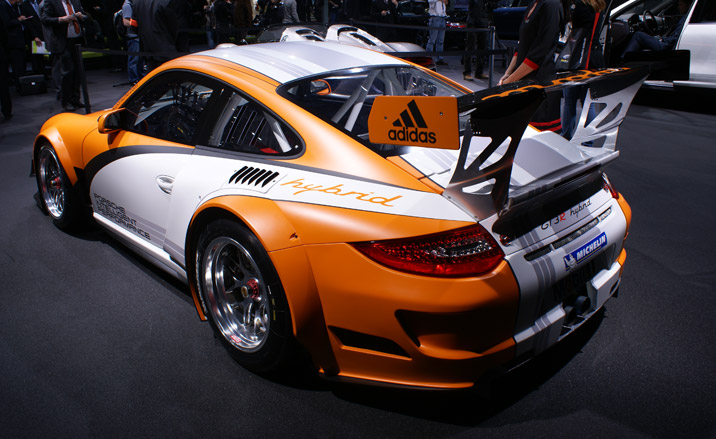
Porsche 911 GT3 R Hybrid

Porsche 918 Spyder: This is a part electric-hybrid two-seater supercar concept housing a mid-mounted 3.4-litre V8 engine. There are three electric motors driving the front axle, and the car can run for 25km in pure electric mode. A dial on the dash allows the driver to choose between electric hybrid, sport and race modes.
The 918 hasn't been designed to look obviously green, but Design Director Michael Mauer and his team have incorporated what he calls a 'mild and wild' theme to differentiate between the car's duel personality – environmental and performance.
He explains: 'When the car is in race mode the spoiler and everything comes out to show that something is about to happen. But when in electric mode it has a less aggressive look.'
Inspiration came from old Le Mans racing cars, which also incorporated covers on the wheels for a more aero efficient drive. The 918 features two exhaust pipes on the side that exist purely as a styling exercise to help clear the rear of the car. The inside hints at the future Porsche cabin with its use of lightweight material, and compact design.
Mauer notes that the sound the car makes is similar to a jet aeroplane. He says: 'I feel Porsche is about understatement. If you take the 911 Turbo, performance-wise it is at least as good as all the Ferraris and Lamborghinis, but looks less aggressive and the design is not telling everybody I am the best.'
'We are developing the best technology when it comes to hybrid cars. I don't think you have to compromise design to visualise eco. But then again, if technology allows for freedom then you should use this freedom.'
At this stage, the 918 may still be conceptual, but it is strongly rumoured to become the street car version of the Le Mans series RS Spyder. 'It drives like a racing car but is for the public road,' says Mauer.
www.porsche.com

Porsche 918 Spyder

Porsche Cayenne and Cayenne Hybrid: The second-generation Cayenne tries hard to look less like a large sports utility vehicle. As a result it is far less imposing in the flesh than its predecessor. 'I wanted to visualise that this is the Porsche amongst the SUVs,' says its designer Michael Mauer. 'Therefore we thought it has to look lighter and less SUV. We wanted to move the expression of the car closer to what we believe the brand stands for.'
Mauer and his team have achieved this by giving the Cayenne a shark like face for a sportier impression. The proportions between glass and body have been changed by allowing for a shallower side glass that creates the impression that the car is lower and more compact than it actually is. In fact the new wheelbase has been extended by 40mm.
Another subtle change has been made to the tailgate. Mauer explains that the old Cayenne had a very 'rational' tailgate - practical for loading but too obvious. The new car's boot is just as functional, but by disguising the shut line it appears less 'SUV' and more sporting.
There is also a hybrid version of the new Cayenne developed with partner Volkswagen's Touareg Hybrid.
On sale: May 2010
Price: Starts £44k
www.porsche.com
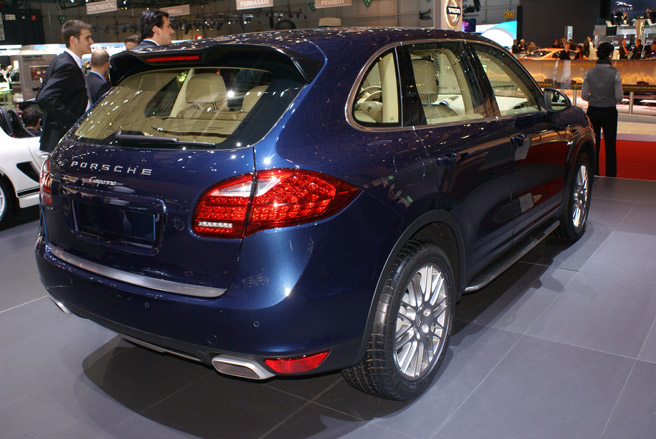
Porsche Cayenne and Cayenne Hybrid

Renault Wind: The two-seater coupé-roadster features an innovative electric roof that pivots open in just 12 seconds.
On sale: July 2010
Price: Circa £16k
www.renault.com

Rinspeed UC?: The name stands for Urban Commuter or You See? The 2.5m long car is designed to be loaded onto customised railcars for longer journeys and use a web-based system for booking into battery-charging stations. The forward-thinking Swiss firm claims there is a good chance it will make it into production.
www.rinspeed.com

Rinspeed UC?
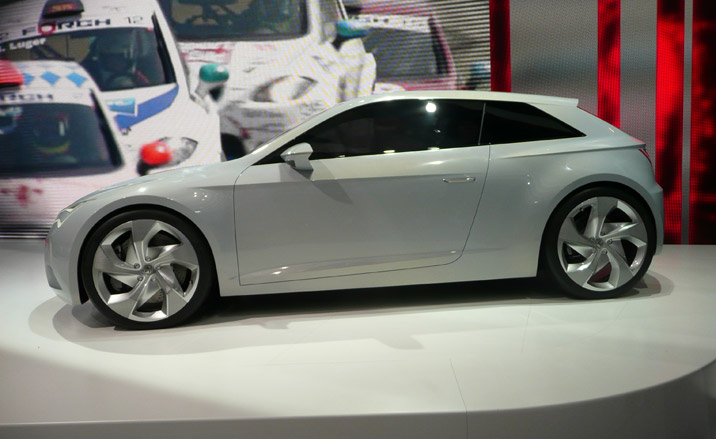
SEAT IBE concept: This is the Spanish firm's first zero-emissions concept featuring an electric motor. It also provides subtle clues as to future SEAT design, starting with the new-generation Leon.
Design Director Luc Donckerwolke says this is the path he intends to take with future SEAT models. 'I am trying to do the minimum with the design - it is about muscle, sexiness and tension,' he says. 'The first line shoots through the eyebrows, over the muscle of the wheel and carries on until it fades into the body at which point another line almost like a musical instrument catches it and gets the rhythm again. And the game starts all over again.'
The low bonnet and long roofline allow for a more compact look. The side mirrors and the unusual graphic lights will be incorporated into future production cars.
Donckenwolk was the designer behind the Murciélago, the Gallardo and the Murciélago Roadster when he steered Lamborghini design back in 2003. He believes that such emotive cars shouldn't only be for the privileged. 'Motorbikes are great in every price range and this is what I want for cars. I want small cars, compact cars, city cars and electric cars to be enjoyable. This for me is a modern four-wheel scooter for young people.'
www.seat.com

Peugeot SRI: The SR1 is Peugeot's vision for an all-new design direction, after a few too many years in the aesthetic wilderness. The 2+1 roadster is not destined for production but does give a good clue to a possible 407 Coupé successor. The SR1 also highlights Peugeot's Hybrid4 system, which goes into production next year on the 3008. The concept also features Bell & Ross original dashboard clock, highlighting an ongoing partnership between the two companies.
www.peugeot.com

Peugeot SRI

Italdesign Giugiaro Proton: This forms part of a range of compact hybrids that Proton and design consultant Italdesign Giugiaro plan to co-develop. The car's hybrid system features a small front-mounted engine that is used to recharge the lithium-ion batteries. The drivetrain is fully electric.
www.italdesign.it
A writer and editor based in London, Nargess contributes to various international publications on all aspects of culture. She is editorial director on Voices, a US publication on wine, and has authored a few lifestyle books, including The Life Negroni.
-
 All-In is the Paris-based label making full-force fashion for main character dressing
All-In is the Paris-based label making full-force fashion for main character dressingPart of our monthly Uprising series, Wallpaper* meets Benjamin Barron and Bror August Vestbø of All-In, the LVMH Prize-nominated label which bases its collections on a riotous cast of characters – real and imagined
By Orla Brennan
-
 Maserati joins forces with Giorgetti for a turbo-charged relationship
Maserati joins forces with Giorgetti for a turbo-charged relationshipAnnouncing their marriage during Milan Design Week, the brands unveiled a collection, a car and a long term commitment
By Hugo Macdonald
-
 Through an innovative new training program, Poltrona Frau aims to safeguard Italian craft
Through an innovative new training program, Poltrona Frau aims to safeguard Italian craftThe heritage furniture manufacturer is training a new generation of leather artisans
By Cristina Kiran Piotti
-
 The return of the Geneva Motor Show (to Geneva) as a place for global debuts
The return of the Geneva Motor Show (to Geneva) as a place for global debutsThe Geneva Motor Show is back. After 2020’s pandemic cancellation and an ‘exported’ event in Qatar in 2023, the organisers of GIMS 2024 had their work cut out to stay relevant. Here are our highlights
By Guy Bird
-
 Geneva Motor Show digital showcase: the luxury edit
Geneva Motor Show digital showcase: the luxury editA digital walkthrough of the Geneva Motor Show 2020 in light of its precautionary cancellation
By Jonathan Bell
-
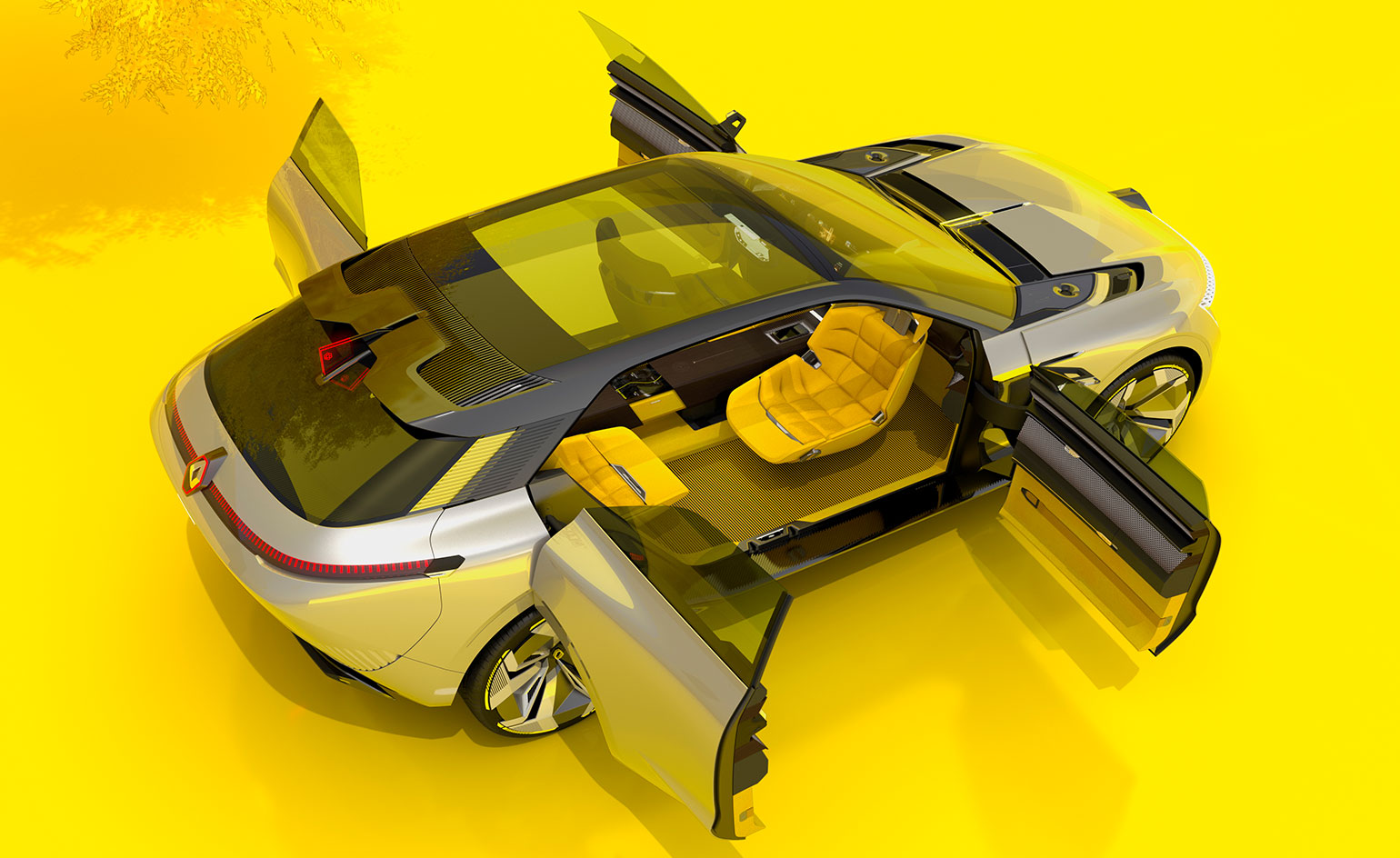 Geneva Motor Show digital showcase: the technology edit
Geneva Motor Show digital showcase: the technology editA digital walkthrough of the best technology due to be shown at Geneva Motor Show 2020 in light of its precautionary cancellation
By Nargess Banks
-
 Next-generation concept cars unveiled at Geneva Motor Show 2019
Next-generation concept cars unveiled at Geneva Motor Show 2019By Guy Bird
-
 Sustainability shapes the narrative arc of Geneva Motor Show 2019
Sustainability shapes the narrative arc of Geneva Motor Show 2019By Nargess Banks
-
 The best new cars launched at Geneva Motor Show 2018
The best new cars launched at Geneva Motor Show 2018By Nargess Banks
-
 7 showstopping concept cars at Geneva Motor Show 2018
7 showstopping concept cars at Geneva Motor Show 2018By Guy Bird
-
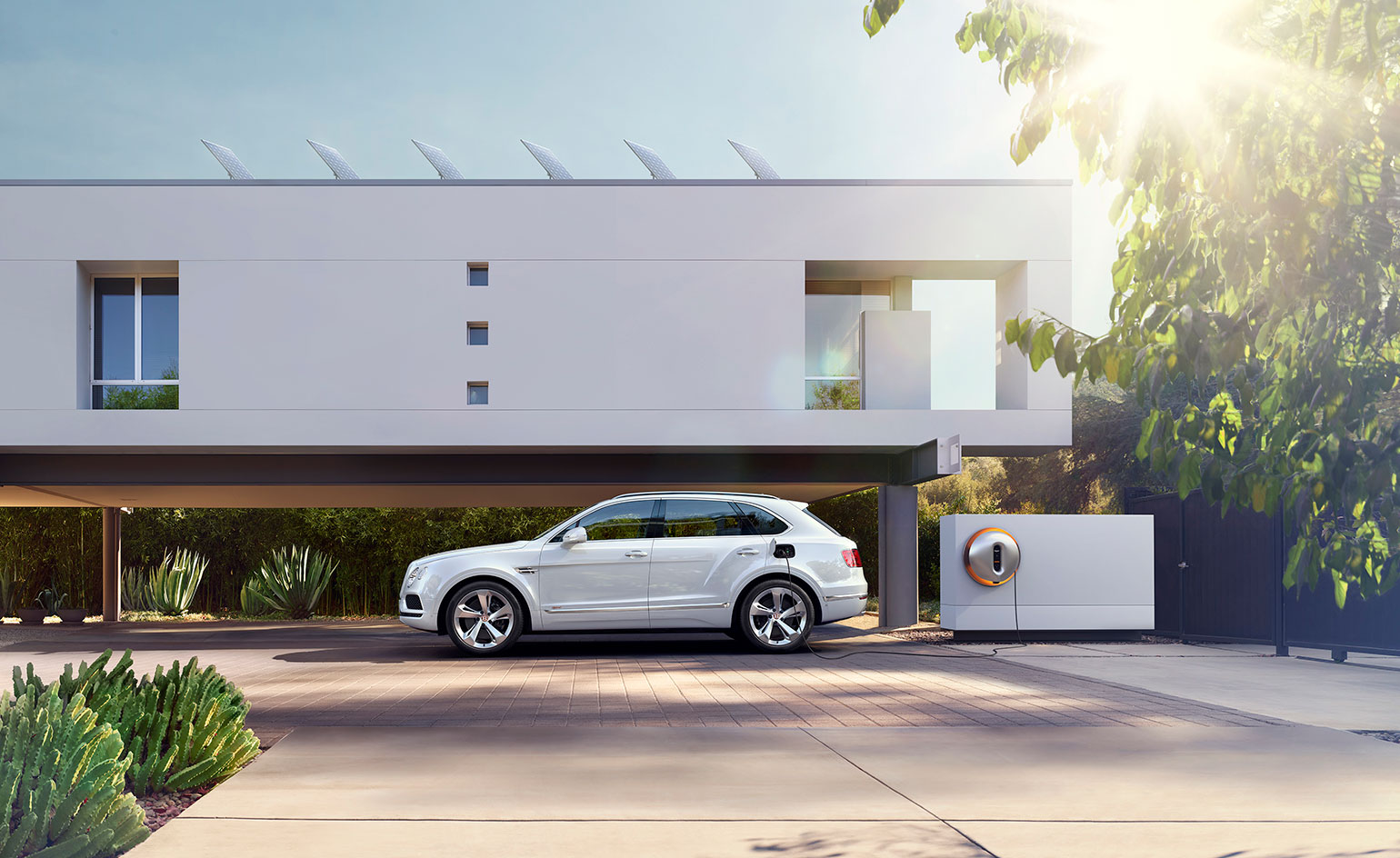 Geneva Motor Show powers up with a Philippe Starck and Bentley collaboration
Geneva Motor Show powers up with a Philippe Starck and Bentley collaborationBy Jonathan Bell